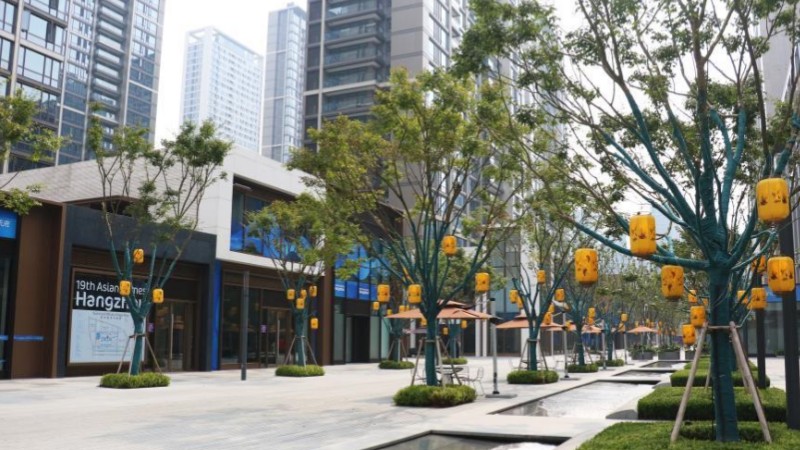Multilingual conductor fosters China-Laos friendship
Zhao Yingjing, 34, in her crisp blue uniform and neatly coiled hair, warmly greets passengers with a bright smile, "Welcome aboard the China-Laos Railway EMU train. Sabaidee ("Hello" in Lao)!" She stands at the door of a car on the D887 "Fuxing" international passenger train as the morning sun rises.
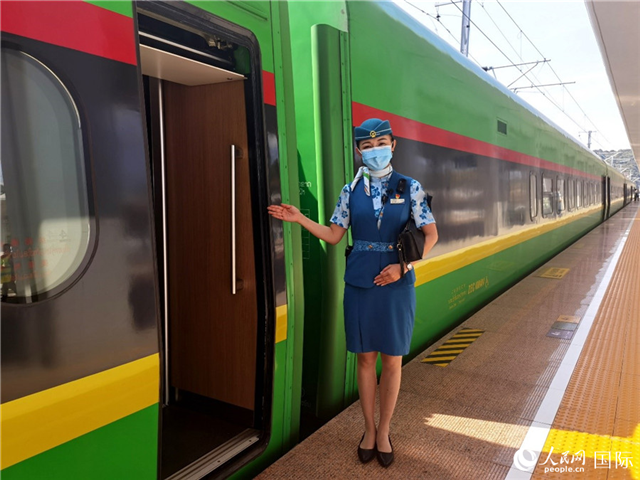
Zhao Yingjing stands outside a carriage of the Fuxing international passenger train on the China-Laos Railway. (People’s Daily Online/Du Mingming)
Zhao is chief conductor of the China-Laos Railway bullet train that connects Kunming in southwest China's Yunnan Province to Vientiane, the capital of Laos. Spanning 1,035 kilometers, the China-Laos Railway is the first international railway built to Chinese standards and is operated by both Chinese and Lao authorities. It stands as a monumental project under the Belt and Road Initiative.
In 2012, Zhao, a Yunnan native, returned to China to become a conductor in Kunming after graduating from university in Thailand.
"I am the third generation in my family to work on the railways. My grandfather and mother are all railway employees, and I grew up with the railway," said Zhao. The frequent rumble of trains passing by and the familiar sight of tracks nurtured Zhao's deep affection for the rail sector.
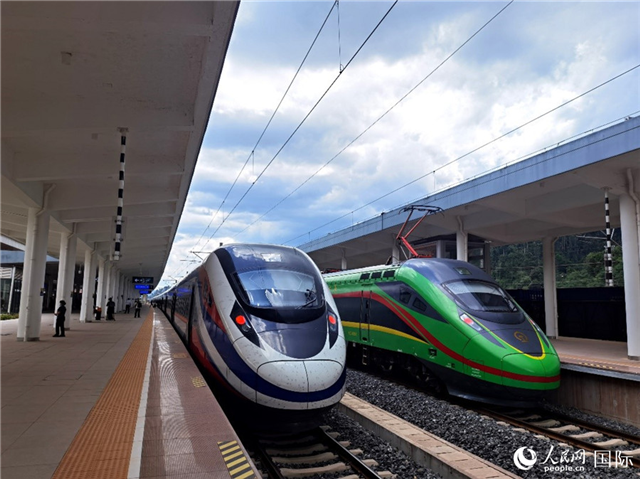
A photo captures a Fuxing bullet train alongside a Lancang bullet train at the Boten Railway station in Laos. (People’s Daily Online/Du Mingming)
Zhao's grandfather was a railway soldier who came to Yunnan to construct the Chengdu-Kunming Railway and stayed in Yunnan thereafter. "My grandfather had a great influence on me. His biggest hope was to build Chinese railways abroad, and he gave me great motivation and encouragement," recalled Zhao. "When the construction of the China-Laos Railway began in 2016, I made up my mind to join this international endeavor."
Determined to excel, Zhao used her free time to upskill. She achieved a high score in the IELTS English exam, mastered Thai and Lao, and learned traditional songs and dances of both China and Laos.
On Dec. 3, 2021, the China-Laos Railway was launched, and on April 13, 2023, passenger services began operations. Zhao was honored to be chief conductor on both pivotal days.
Transitioning from conducting slow trains to the high-speed "Fuxing" bullet train, Zhao has witnessed many significant milestones in China's railway sector over the past decade.
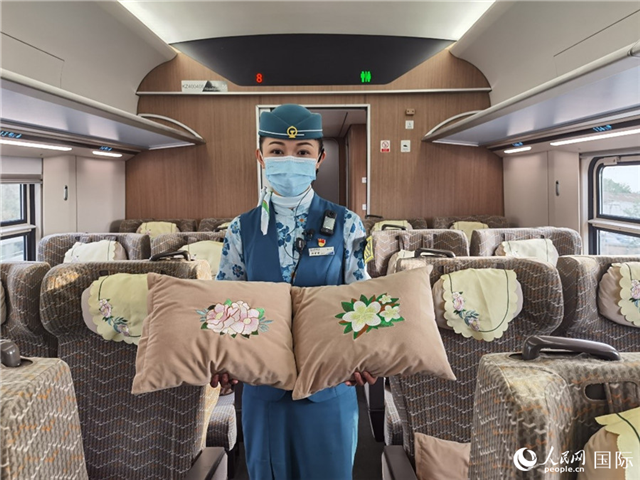
Zhao Yingjing displays cushions adorned with patterns of Chinese peony and Lao Champa flowers onboard a train on the China-Laos Railway. (People’s Daily Online/Du Mingming)
Today, it's a mere nine-and-a-half-hour journey from Kunming to Vientiane aboard the China-Laos train. The "Fuxing" train embarks from Kunming South Railway Station, while the "Lancang" train, adorned in the red, white and blue of the Laotian national flag, begins its journey at Vientiane Station in Laos.
Zhao points out the train’s thoughtful decorations. The predominantly blue tablecloths are adorned with peonies and cuckoos, symbols of peace and friendship. The blue represents the Lancang River, a vital source for both the Chinese and Lao people, and the shared blue sky overhead. The color choice reflects the hope for lasting friendship between the Chinese and Lao people.
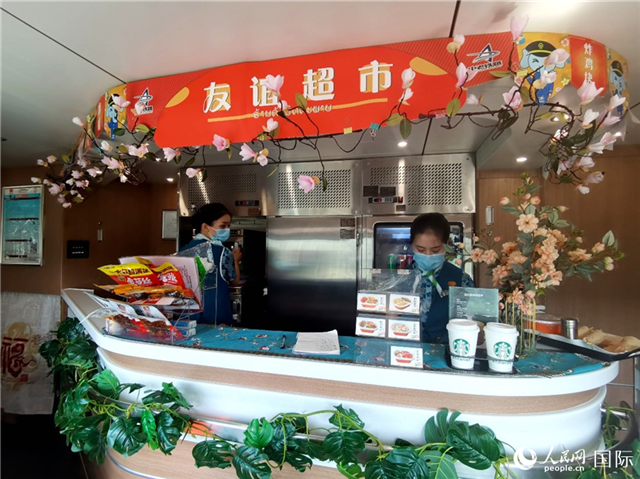
A photo showcases a "Friendship Supermarket" inside an international passenger train on the China-Laos Railway. (People’s Daily Online/Du Mingming)
The train’s details exude coziness throughout. Glass doors between the cars showcase heart-shaped patterns made of intertwined Chinese peony and Lao Champa flowers. Beneath each seat are Chinese and Lao standard power sockets. Sanitary bags bear the imprint of the Lao Triumphal Arch, while cushions are adorned with peony flowers and Champa flower motifs. Additionally, train information displays, broadcasts and service signs are available in three languages: Chinese, Lao and English.
As Zhao patrols the cars, assisting passengers, she feels most proud when communicating freely with foreign tourists and helping them. "Most international passengers are far from home, and speaking their native language gives them a sense of home."
According to Zhao, the passengers' recognition of the crew’s efforts is encouraging. "We see ourselves as bridges of friendship between China and Laos, even as bridges of international friendship sharing China's rich culture," she said.

Passengers are seen boarding an international passenger train on the China-Laos Railway at the Luang Prabang Station in Laos. (People’s Daily Online/Du Mingming)
"When on duty, we not only serve passengers, but also act as cultural ambassadors to spread Chinese culture," noted Zhao, emphasizing the significance of train conductors on the China-Lao railway.
Directly connected to China's railway network, this connection stands as a testament to China's Belt and Road Initiative. It serves a strategic goal: transforming Laos from a land-locked country into a land-linked country.
As of Aug. 15, the Mohan Entry-Exit Border Checkpoint in Yunnan, located on the China-Laos border, has inspected a total of 246 China-Laos international passenger trains, facilitating 52,888 inbound and outbound visits from 53 countries and regions.
Departing from Kunming South Railway Station, the service passes through the magnificent scenery of Xishuangbanna in Yunnan. It then traverses the China-Laos border through the Friendship Tunnel, stopping in Laotian cities such as Luang Prabang and Vang Vieng before concluding its journey in Vientiane.
"This train carries dreams, happiness, and friendship. I hope the train will reach farther places, at a higher speed and operate more smoothly. I hope it will bring hope and happiness to more people," said Zhao.
Photos
Related Stories
- Lao PM vows closer cooperation to support Belt and Road Initiative
- Chinese doctors perform over 10,000 free cataract surgeries in Cambodia, Laos
- Senior CPC official visits Laos
- China-Laos land port has handled over 1 mln people this year
- China's top legislator holds talks with Lao National Assembly president
Copyright © 2023 People's Daily Online. All Rights Reserved.









